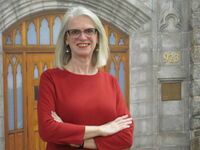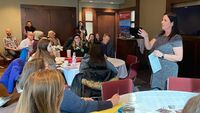By Erin Elaine Casey |
In 1995, a small group of people had a big idea: a university extension program that would grant degrees in the tiny West African country of The Gambia. About twice the size of greater Halifax, and almost entirely surrounded by Senegal except for a small strip of Atlantic coastline, the Republic of The Gambia had no university of its own. What it did have was a hunger for education and a need to keep its best and brightest at home.
Four years later, the very first class graduated from the Saint Mary’s University Extension Program — or SMUEP — in The Gambia. On February 16, 1999, 62 students walked across the stage to claim hard-won bachelors degrees in the first-ever Saint Mary’s convocation to take place outside of Halifax.
How did such an unlikely and wonderful relationship come to be?
The Nova Scotia Gambia Association (NSGA) is a Halifax-based NGO that works with West Africans and Canadians to build healthy communities in The Gambia. Burris Devanney BA ’59 led the organization from its beginnings in 1984 until 2006, and is still deeply involved today. An English teacher and high school principal from Halifax, he had lived and taught in The Gambia in the early ’80s.
“About 50 students a year were going out of the country to study. They were sending people abroad to Nigeria, Ghana, Sierra Leone, and some to England,” Devanney explains. “I proposed the idea of a university extension program to the Minister of Education in The Gambia. She took it to Cabinet. Cabinet liked it and said do it.”
Devanney took the idea to Denis Leclaire, Director of International Activities at Saint Mary’s at the time. They went to Dr. Michael Larsen BA’66, Professor of English at Saint Mary’s for 40 years and then Dean of Arts, and together they developed a modified version of the summer school format to export to The Gambia. With a workable plan in place, Dr. Ken Ozmon, President of the university from 1979 to 2000, was approached. He liked the idea, and the SMUEP was off and running.
“It was one of our first forays into the international scene,” remembers Ozmon. “It really was quite an exciting step for Saint Mary’s. The professors loved going over there to teach, and we used it as an opportunity to give staff an international experience, too. The Gambia didn’t have any university structure at all. We had to help them establish a university senate, board of governors, and business office.”
By the fall of 1995, the SMUEP was offering a 15-credit BA in The Gambia, including Arts, Humanities, and Social Science courses. Basic Business and Science courses were added later. “The lack of higher education in The Gambia really affected all their sectors: government, banking, legal, scientific, medical,” explains Larsen. “Quite often when they sent students abroad, they wouldn’t come back. They were suffering from a brain drain.”
“One of the things that surprised me was how quickly various people got on board with the idea,” adds Larsen, “including the president, faculty, administrators, admissions, the bookstore, and the registrar’s office. Pretty much everyone asked, ‘What can we do to make this happen and make it better?’ It really did bring out a lot of good in people.”
“I think people get into the business of higher education or teaching because they have a commitment to enhancing the potential of young people,” adds Larsen. “We were working together on something that was manifestly what we were trained for: offering education to people who were hungry for it but had no opportunity.”
Devanney describes the working conditions. “Students went to school in the morning, and then TAs were available from two to seven. Some students didn’t have electricity at home, but they always came in very well prepared.” Professors came from Saint Mary’s and other universities, including Dalhousie. “They worked for minimal salary, sessional pay. Travel and housing was provided, and the whole structure worked.”
The Gambian students were eager to learn and a pleasure to teach, and “everybody was impressed by their level of commitment and work ethic and background,” according to Larsen. In the 2006 book Partners for Progress: A Canada-Africa Venture in University Building, Larsen writes that “many professors in the SMUEP claimed that it was the highlight of their academic career.”
Heidi Taylor was the Program Manager of the International Activities Office for about 20 years and retired in 2007. She was the primary liaison amongst all the different stakeholders. “It was a gigantic leap of faith in so many ways,” she says. “I made an initial trip to The Gambia with Elizabeth Chard, who was our Registrar. Just to see her interacting with the students there, and the sparkle of those connections. The logistics just sort of melted away.”
It’s been exactly 20 years since that first Gambian convocation. The ceremony took place at the Kairaba Beach Hotel in Banjul. The proceedings were played in their entirety on Gambian radio and television, and covered extensively in print media. It was, after all, the first university convocation ever to take place on Gambian soil. The country’s President attended, in addition to many other dignitaries.
Valedictorian Momodou Sabally BA’99 remembers well the enormous pressure he was under to make his speech count. “It felt like having to take a penalty that would be a decider for your national team in a crucial international soccer game.”
In Partners for Progress, Sabally writes of his classmates on that day that “you could sense the pride, joy, and fulfillment they exuded. They were the ladies and gentlemen to be admitted into the prestigious Saint Mary’s University Alumni Association that spans the length and breadth of the world.”
Murray Wilson BA’65 BEd’70, Associate Registrar from 1972 to 2007, remembers feeling excited but a little overwhelmed. “After I got over the initial shock of the convocation happening over there, it was fantastic,” he laughs. “When Elizabeth told me, I nearly fell under my desk! The second shock was all of the things necessary for the convocation — the regalia, the hoods, all that had to be shipped. We all went: Elizabeth, me, Mike, Keith Hotchkiss BA’73 from Student Services, the President of the Student Association Trevor O’Brien, Public Affairs Officer Paul Fitzgerald BA’97 MA’06, President Ken Ozmon. It was quite a parade!”
“I was responsible for the parchments,” adds Wilson. “I thought: these have to stay in my hot little hands from Halifax to The Gambia. And they did not leave my person from here to there.”
The significance of the SMUEP to development in The Gambia cannot be overstated. In 1996, Saint Mary’s received substantial Canadian International Development Agency (CIDA) funding for a project to build Gambian capacity for providing higher education. This, in collaboration with Gambian efforts, resulted in the Gambian government passing an act establishing the University of The Gambia in 1999.
The SMUEP ended in May 2000. A total of 385 students had participated in the program. Of those, 174 had graduated. Another 100 earned Saint Mary’s degrees through transfer credits from the University of The Gambia and other institutions, with a few transferring to Saint Mary’s in Halifax. In the end, the SMUEP graduated nearly 300 students.
“SMUEP graduates can be found in every nook and cranny of The Gambia’s workforce,” says Sabally. “The current Environment Minister is one of them. The head of The Gambia Revenue Authority and his Deputy, the Director of the National Council for Arts and Culture, the deputy CEO of the national utility authority, and the head of the Gambia Bureau of Statistics and his deputy are all graduates from my class.”
Sabally himself has had an incredible career. He is currently CEO of his own consulting firm, Pen’s Den Consulting, and President of Sabally Leadership Academy, a youth empowerment foundation. He has also held more than half a dozen key positions in the Gambian government, including Minister of Presidential Affairs and Head of the Civil Service. Sabally recently published a memoir and released a film about his experiences with the SMUEP.
“My educational experience with SMUEP was the foundation upon which all my achievements were built,” he says. He now holds a master’s degree in economic policy from Georgia State University.
One of Sabally’s classmates, Abdou Jeng BA’99, agrees. “Really, this opportunity opened a series of benefits in my life. I feel privileged to have a Saint Mary’s degree. I am now with The Gambia Customs and Excise Department as manager at the post-clearance audit unit. From 2012 to 2018, I was in Dakar as the Customs/Commercial Attaché at the Gambian Embassy in Senegal.” He now holds a masters in international relations.
Sabally adds, “The SMUEP experience is a classic example of what benefit humanity could gain from creative North-South cooperation.”
In 2018, Burris Devanney and his wife Louanne visited The Gambia. They were invited to the home of Yankuba Darboe BA’99, the first president of the SMUEP student union, and his wife Rohie Bittaye, another SMUEP ’99 graduate. “Yankuba was in charge of the Gambian Revenue Authority and his wife was Permanent Secretary of the Environment Ministry. We went for Saturday lunch with at least a dozen people who had been through the SMUEP. Among them were two ministers of government, at least three provincial secretaries, and people who ran things like the national archives and other agencies and departments.”
“They became a cadre of people who were full of confidence, educated, and they all knew each other and worked to assist the public sector of their country. That wouldn’t have happened without the SMUEP. Even the ones who went away as grad students came back and resumed their roles in the cadre.”
After lunch, someone handed Devanney a cell phone. “It was the new president of The Gambia, Adama Barrow. I didn’t know him but I spoke to him!” he laughs. “This is where these people are — they are very, very influential in how the country is being run.”
Burris Devanney’s new book, The Gambia Saga, published by New World Publishing, will be launched on the evening of Thursday, May 30th at Saint Mary’s University in the McNally Auditorium. The book covers his work in The Gambia over a span of 38 years, including the 34-year history of the Nova Scotia Gambia Association. Everyone is welcome. All royalties from book sales will go toward NSGA’s work. Find out more about the Nova Scotia Gambia Association at:
www.facebook.com/novascotiagambia/




